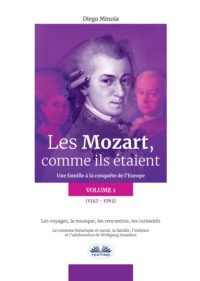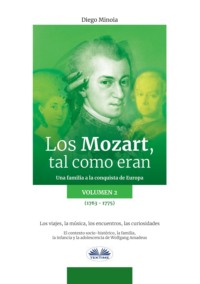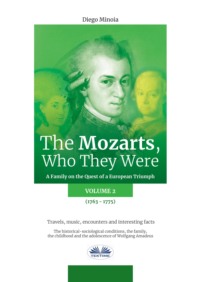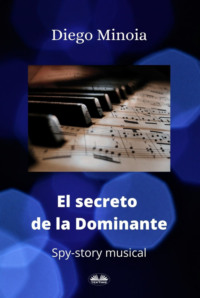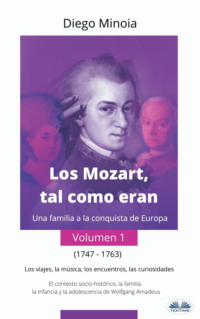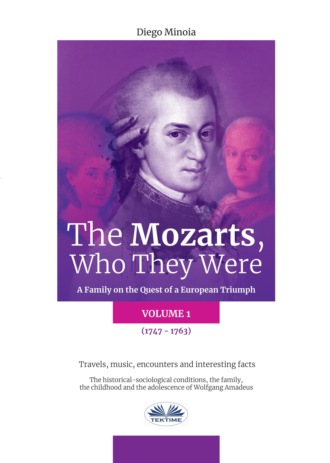
Полная версия
The Mozarts, Who They Were (Volume 1)
- Court Organist: Johann Ernst Eberlin (from 1727)
- Leopold Mozart: 1744; added to his role of violinist, he was hired to teach violin and keyboard to the children in the Cathedral Choir; he married in 1747
- Archbishop Prince: Andreas Jakob von Dietrichstein (from 1747 to 1753)
The Mozart family: 1751, Nannerl Mozart is born
- Archbishop Prince: Sigismund III Christoph von Schrattenbach (from 1753 to 1771)
- Kapellmeister: Giuseppe Francesco Lolli and Johann Michael Haydn (from 1762)
- Court Organist: Anton Cajetan Adlgasser (from 1762)
- Leopold Mozart:
1756: published the Violin School, Wolfgang is born
1757: appointed Court Composer
1758: promoted to 2nd violin in the Court Orchestra
1763: appointed Vice-Kapellmeister
Wolfgang Mozart:
1769, appointed 3rd Master Concert Performer to the Court, without a salary
- Archbishop Prince: Hieronymus Joseph Franz de Paula Colloredo von Wallsee und Mels (from 1772 to 1803)
- Kapellmeister: Domenico Fischietti (from 1772); Luigi Maria Baldassarre Gatti (from 1783)
- Court Organist: Wolfgang Amadeus Mozart (from 1777)
- Leopold Mozart: Court Composer (with Caspar Cristelli and Ferdinand Seidl)
- Wolfgang Mozart:
From 1772, he was violinist at the Court Orchestra without a salary, followed by Concert Master with a very low salary of 150 florins annually. In September of 1777, he left the position in order to travel to Munich and Paris. Upon his return in January 1779, he was appointed the position of Court Organist and Concert Master. In Vienna, April 1781, he resigned permanently from the services of Archbishop Colloredo.
The Mozart family
We can begin with a "snap-shot" of the epoch with the celebrated painting by Johann Nepomuk della Croce that represents the Mozart family in 1780/81. It depicts Wolfgang and his sister Nannerl at the keyboard during the performance of a piece with four hands while their father, Leopold, poses nearby listening with his violin, ready to intervene. The oval-shaped portrait hanging on the wall portrays their mother who had passed away in Paris four years earlier. And hanging on the right is Apollo, the Greek God of the arts, displayed with the instrument devoted to him: the cithara. The Mozart family was formed 21 November 1747 when the 28 year-old Leopold Mozart married the 27 year-old Anna Maria Pertl at the Salzburg Cathedral after a rather long courtship. They were reputedly a handsome couple and enjoyed a solid marriage over the years, as we learn from the family correspondence available to us. In one letter sent to his wife, Leopold Mozart who was traveling with their son, Wolfgang, writes: "Today is our wedding anniversary. If I'm not mistaken, twenty-five years have passed since we had the joyful idea to marry: the fact of the matter is that we had this idea many years prior. The best things in life come to those who wait!".
In that era, roles were well-defined and customs and traditions were highly respected. The husband took care of all things related to finances and society (Leopold was extremely meticulous to the point of fanaticism as we will see in his letters), while the wife looked after the household and children, maintaining relations with their circle of friends or people who were in some way useful to reach certain purposes. The Mozart couple had seven children, but only two survived, the fourth-born Maria Anna (Nannerl) in 1751 and the seventh-born Wolfgang (Wolferl for family members) who came into the world in 1756. The mortality rate for childbirth in that epoch was a situation that was painfully accepted by parents who, for this reason, gave birth to many children. Wolfgang, himself, had six children of which only two survived.
In Nannerl's Diary which was written from 1775 to 1783, we learn that the Mozart family had a wide range of acquaintances, with friends who visited them at their home (some on a daily basis) or who they visited in their friends' homes, as well as the students of Leopold and Nannerl. They passed their time together chatting and gossiping or playing cards (tresette, tarocchi, briscola, etc.) or at range shooting played with air-compressed guns always made with small wagers of money or birilli (a game similar to bowling). The guests frequently stayed at the Mozart's home for meals and likewise the Mozart family was often hosted at their friends' homes to dine. And naturally, there were many occasions to play music. To begin with, there were the music lessons; Leopold taught violin while Nannerl taught the harpsichord at the Mozart residence or at the students' homes. But in the household, Mozart also played music with his circle of friends from Salzburg, many of whom belonged to the Orchestra of the Archbishop Court. He also played with foreigners passing through the city who were invited by Leopold or brought to him by his circle of friends who regularly visited.
Nannerl's friends would style her hair, accompany her for walks along the city walls (which no longer exist today), participate in the almost daily religious receptions which were often accompanied by the music of the Court composers such as Eberlin, Adlgasser, Michael Haydn and Wolfgang Mozart, himself. Processions were another attraction for the people, especially those of solemn occasions of which the Archbishop Prince would make an appearance. Or, as on the occasion of the Feast of Corpus Christi where they were accompanied in grand style by the Order of Chivalry, as was written in Nannerl's diary, Wolfgang couldn't resist making fun of the fact that on the occasion of a visit to the Hagenauer family (the previous owners of the Mozart house in Getreidegasse), he "saw the horses crapping" and dropped a lit candle on the procession.
Things wouldn't have been complete without blasphemous distractions, such as the frequent participation of the Mozart family (even for many days in a row) of the comedic performances proposed by the theatrical companies that toured Salzburg and would stop over for a few weeks where they offered various shows from their repertoire. In 1779, for example, Johann Bohm's theatrical company settled in Salzburg for the season, proposing over the course of the year about ten encore performances (in the neighborhood of sixty, according to Nannerl's diary) of a variety of comedies and ballets, which were, in truth, judged as "very bad". There were also the musical academies and ballets, as well as the evenings of weekly ballroom dancing, mostly during the Carnival at the Town Hall.
Here is the musical program of an academy held on 18 March 1779. (In Nannerl's diary, the twenty-three year-old Wolfgang sometimes wrote in his sister's journal with his characteristic gags, describing the academy as "trendy crapademia"):
1 -- a symphony (the Haffner Symphony KV385 composed by Wolfgang -- A/N);
2 - an Italian aria;
3 - a trio with three voices by Antonio Salieri (Imperial Composer and Kapellmeister during that epoch in Vienna -- A/N);
4 -- a cello concert by Joseph Fiala (oboist, cellist and friend of Mozart -- A/N);
5 -- a voice aria, oboe and harp;
6 -- An aria with trumpets, timpani, flutes, violas, bassoons and basses written by me (Wolfgang -- A/N);
7 -- Anfossi's first finale from "Perseguita incognitata" (Wolfgang's comically twisted title of the opera; the correct title by the composer Pasquale Anfossi's opera is "L'incognita perseguitata" (A/N);
8 -- out of mere compassion did we let Ceccarelli sing a Rondeau (Ceccarelli was a "castrato" and family friend who served the Salzburg Court, and for whom Wolfgang wrote an aria and an acting part -- A/N);
9 -- In conclusion, we performed in the entire city of Milan n.b.: with trumpets and timpani.
Moreover, on special occasions there was other forms of entertainment, such as fireworks in the Summer Equitation School.
Another fashionable activity during the mid-eighteenth century (also documented as a pastime in the Mozart household) was the silhouette, a portrait technique that traced the outline of a person or object and coloring the entire subject in black. This was achieved by hanging a white cloth in front of the subject while it remained back-lit, highlighting the outline. Among these activities (with the exception of brief lessons nearly everyday), there were of course the responsibilities at the Court that weren't particularly demanding for concerts or various tasks, such as Leopold's job tuning the piano at the Archbishop's summer residence at Mirabell Palace.
Sometimes walks were taken in the gardens of the Mirabell Palace, in the newer part of the city on the other side of the river. Alternatively, there were excursions outside of the city walls, such as the visit in 1780 to the salt refinery and San Zeno (remember that rock salt was the principle source of wealth in the region, of which is derived the name of the city of Salzburg, the castle of salt and the Salzach River - the passage of salt). One last interesting fact regarding the Mozart family is the ciphered code that Leopold and his wife used to avoid the curiosity of censorship (during that epoch, letters and correspondence were often opened and read to monitor the subjects' thoughts and ideas in order to avoid conspiracies). The letters that Leopold wrote were meant to circulate around Salzburg to express recognition of the musical feats that were accomplished in the various courts, consequently the secret code was used to communicate with his wife the occasions in which there were lies present in their correspondence to be fed to the Archbishop.
The most glaring examples we find in the letters from Milan, sent over the course of Leopold and Wolfgang's third and final Italian journey in which he complains of a terrible pain in his arms and legs that kept him from departing for their return to Salzburg. In truth, he was procrastinating in order to find out the result of his contacts with Peter Leopold of Habsburg-Lorraine, Gran Duke of Tuscany, regarding Wolfgang being hired by the Florentine Court, which turned out to be unsuccessful. Leopold was, unfortunately, obliged to return to Salzburg with his tail between his legs, his great Italian dream vanished.
Looking back at the coded language, it was nothing particularly complex and if a censor were to have gone to the trouble of deciphering it, they would have probably figured it out. Besides, it appears that none of the letters with coded parts were chanced upon by the monitors because, if they had been, the censor would have surely been curious to know which secrets might have been revealed in these senseless sentences included in letters that were otherwise easily comprehensible. And the methods for saying it were surely not lacking. So here is the little Mozart family secret: substitute the vowels of some of the words with consonants
A = M E = L I = F O = S U = H
Instead of Milano, they would have written Mflmns
Wolfgang's mother
Anna Maria Walburga Pertl (1720 -- 1778), was born in St. Gilgen, a small village situated 545 meters above sea level on the banks of Lake Wolfgangsee, approximately thirty kilometers from Salzburg, the region's capital. It lies in a pleasant area and was enriched by small alpine lakes. In that epoch, there were just a handful of homes inhabited by farmers.
Anna Maria's father, Wolfgang Nikolaus Pertl (married to Euphrosina Puxbaum, the daughter and widower of two musicians of the church), completed his law studies and began a promising career as a state official in Salzburg, Vienna and Graz. However, an incapacitating disease forced him to accept a lesser job as Vice Superintendent at Huttenstein, a town near St. Gilgen, with a reduced annual salary of 250 florins. Taking into consideration the situation (imagine that today the town has little more than 3,000 inhabitants, divided into 7 districts and that at that time the population was much lower) such a position wouldn't be particularly honorary, let alone well paid. At her father's death in 1724, the family lived in serious poverty with debts of more than one thousand florins, causing their assets to be repossessed. This situation forced the wife to make the decision to return to the family's place of origin in Salzburg with two small children, one of which died shortly after. Here, they lived a life of misery, managing to survive only thanks to a town welfare payment and minimal domestic jobs for other families. Therefore, we can assume that Anna Maria and Leopold's first meeting surely occurred in Salzburg.
The cultural habits of farm life acquired in St. Gilgen and the environment of the impoverished in Salzburg must have certainly impacted Anna Maria's formation which highlights, as sources tell us, a certain spontaneous and simple zest for life combined with an enjoyment for crude banter, even to the point of exceedingly vulgar. These traits were passed on to her son, Wolfgang, as well as her "poetic" gift of rhyming all words related to the digestive and intestinal tract.
Following are a few fragments of a rhyming composition (in German) sent by the twenty-two year old Amadeus to his mother on 31 January 1778: "(...) They are also from people who carry crap in their belly/ but who let it out before, as well as after the revelry. They pass gas all night long/ in such a way as to resonate valiantly. (...) As of now we have left more than eight days ago/ and we have already shit in huge quantities.". In all fairness, it should be stated that their father was not immune to the same literary pinnacles, at least as far as the same vulgarity among members of the family.
Let us now look further into Anna Maria's "colorful eloquence". Following is one of the most famous examples. A segment of a letter that the fifty-three year old Mrs. Mozart sent from Munich to her husband, Leopold (who had remained in Salzburg): "Goodbye, my darling (the original in Italian -- A/N), be well, into your mouth your arse you'll shove. I hope you sleep well, but first shit in the bed until it explodes, it's already past one o'clock, now you can make a rhyme", Munich 26 September 1777. The translation from German, besides the explicit significance, doesn't allow us to understand the playful tone given that the text is in rhyming couplet and ends with a riddle of a fecal nature. This very same "poem" was later partially used by Wolfgang in the lyrics to one of the Canons composed around 1788 (in Vienna) for the amusement of his friends, "Bona nox! Bist a rechta Ox" ("Good night! You are a true ox"), in 4 voices a cappella.
Endowed with a limited culture (which was not uncommon among most of the population in that epoch, especially amidst the women), Anna Maria always possessed a subordinate role toward her husband, as well as her son, as was demonstrated during the journey to Paris (which, as we will see, proved fatal for her), during which she remained passive to the indications from her husband in Salzburg and the differing aspirations of Wolfgang. She didn't speak any language except her own "Salzburg" German. In fact, during the European journeys carried out by the family, she associated only with German expatriates at public or business functions.
We can discern a pleasant disposition. However, as far as culture and knowing her station in society (even with later attendance at the European courts which had most certainly helped refine her), she was lacking. Here is an example of her ungrammatical way of expressing herself in writing (and I do believe that her speech was similar): "(...) I hope that you and nanerl is well, what is my bimperl up to (the family dog, A/N), it's been awhile since I've not heard nothing about him..." Letter from Mannheim to her husband, 31 October 1777 as quoted by W. Hildesheimer. Though she did have the opportunity to refine her ways through her initial association with her circle of Salzburg friends of the family (the smaller local nobility, as well as the well-to-do high society) and later, with some of the principal European courts thanks to the exhibitions of the two child prodigy children.
Wolfgang's sister
Maria Anna Walburga Ignatia Mozart (1751 -- 1829) Wolfgang's sister, five years his elder, also had a musical formation that led her to become a very accomplished harpsichordist / pianist. Thanks to the Mozartian correspondence, we know that in the family she was usually called by the affectionate nickname of Nannerl (Nannina, Annetta). Her father began her musical formation at age seven, teaching her to play the harp and fortepiano, as well as voice lessons. While she was very close to her younger brother, with whom she undertook the first long European journeys in the role of one of the prodigious children, she was, however, taken less seriously by her father than her brother.
The reasons for this attitude, seen through modern eyes as certainly discriminatory, were at least two: as five years older than Wolfgang, Maria Anna inspired less of an impression as a "child prodigy" and consequently, her career was destined to be shorter term. Evidence of the favored treatment that their father used toward his son (and as can be observed today and which does not do Leopold Mozart honor), concerns two cases of illness and recovery. In November 1765, while returning from London on the first great journey that the entire family had embarked upon, Nannerl fell ill in Holland of a pulmonary disease that was so serious as to have her last rites given in danger of death. Fortunately, she recovered and Leopold then wrote to his trusted friend, Hagenauer, to have 6 masses celebrated in thanks at the various churches of Salzburg. The following month, again in Holland, Wolfgang fell ill with a sort of typhoid fever and after his recovery, Leopold ordered 9 masses of thanks to be celebrated, (3 more than those dedicated for the recovery of his daughter).
We can say that Leopold concentrated his "investment" of time, energy and expectations upon his son, younger and possibly more gifted; who knows if Nannerl would have contributed the same results as her brother if she had been as sustained and supported as him. In a letter from Wolfgang to his sister, we understand that she, too, was an active composer, but the correspondence of Leopold makes no mention of any compositions or creative activity of his daughter, which in any case were never attained. The artistic-creative level of Nannerl remains, at present, an unresolved mystery.
The second reason for the preferential treatment, typical of that epoch, had much to do with being a female. In that era, it was a common and undisputed school of thought that females were inferior and Leopold Mozart was no different in this way. In a letter dated 12 February 1756 to the publisher Lotter of Augsburg, Leopold complains of the delay in the printing of his book "Scuola di Violino", and writes: "Ah, if only Mrs. Lotter were able to arrange the typeface as well as she was able to deliver a male infant to the midwife instead of a half note. Oh, I know that my book would have been ready a long time ago" (the half note is the equivalent to a female infant rather than a male infant). Noteworthy is the consideration, equally common, that women were not able to reach excellence in art and that it was unsuitable for a woman of public morality to make her mark, living between continuous travels and encounters of all types. The objective was to be modest and find a good match to create a family which was seen as a priority compared to artistic talent.
As a matter of fact, Nannerl sacrificed her own career looking after her father after her mother's death, remaining subordinate to his wishes to the point that she even renounced her true love to the Captain of the Court Major Franz Armand d'Ippold, who had asked for her hand in marriage without first getting permission from her father, Leopold. She did, many years later, marry a widow with children much older than her who was well-received by her father.
It is interesting to note that the "musical relations" involved not only the male aspects of the families, but the female, as well. As Leopold Mozart, and later Wolfgang, were on friendly terms with Eberlin (organist and later Kapellmeister) and Adlgasser (Court Organist), their respective daughters were friends with Nannerl. In her diary, for example, she writes that on 26 September 1777, Waberl Eberlin paid her a visit and Viktoria Adlgasser styled her hair.
Having become too "old" to be a "child prodigy", she was relegated to Salzburg with her mother while her brother and father embarked on the three formative journeys to Italy. Then, later on, when Wolfgang went on his umpteenth journey to Munich and Paris accompanied by his mother (Leopold did not receive permission to take leave from work), she stayed behind in Salzburg with their father. No doubt, Maria Anna would remember for the rest of her life, with regret, the successes of her youth and the concerts at the European Courts where she performed solo and coupled with her brother. She continued to give piano lessons in order to contribute to the family budget and was copyist for her brother and father's music as was necessary for their travels.
The notations in her diary entries, before she married, though embellished with French middle class expressions with international pretensions such as "comedie, en visite, etc.", still convey a sense of sadness in the way she describes how her days passed between the death of a person, the arrival of an elephant in Salzburg or of a "dog doctor", combined with encounters with her friends who styled her hair, had a coffee together, accompanied her to the market, played cards or went range shooting...and of course, she looked after her father and the family dog, a fox terrier called Miss Pimperl, also known as Bimbes, as Wolfgang writes from Vienna in August 1773. On 3 September 1777, she writes in diary, that her day is limited to brushing her hair alone, mass at 10:30, the purchase of a string for her nightgown and a walk with a friend.
The bond with her brother, which was very strong in infancy and childhood, abated as Wolfgang matured. They grew even farther apart after his departure for Vienna in 1781, and especially after their father's death. In the letters that were discovered after Leopold's passing, it appears that Wolfgang, apart from his words regarding the circumstances, was principally interested in his part of the inheritance and was worried that there were not sufficient pecuniary calculations. In fact, once the assessment was finalized, he asked that payment be made in Viennese currency rather than Salzburg currency, giving him an advantage in the monetary exchange.
In 1784, at 33 years old (a decidedly advanced age for a girl to find a husband in that epoch), Nannerl married Johann Baptist von Berchtold zu Sonnenburg, fifteen years her senior and twice widowed with five children, who later had another three with her. Her husband descended from a family of recent and minor nobility. It appears that he wasn't a kind man, making married life less than happy for Maria Anna who also had the responsibility of raising her husband's children from his former marriages. After having refused all of his daughter's suitors, Leopold married her off out of convenience in exchange for 500 florins from von Bertchold as a "Morgengabe", (a promise sealed according to the German tradition made upon the morning after the wedding) and as praetium virginitatis (the price of the virginity of the bride).
After the wedding, Maria Anna moved to her mother's birthplace of St. Gilgen, just a few hours' carriage ride from Salzburg where her husband conducted his business as magistrate and where, in 1792, he obtained the title of Baron. We should clarify, however, that the noble titles of that era did not carry the weight and prestige of previous times. Titles were easily bestowed and were often purchased by well-to-do families who had become affluent.
Moreover, it should be remembered that Count Arco, famous for having dismissed Wolfgang Mozart with a kick in the seat of his pants, was indeed of noble lineage, but was nothing more than an official person in charge of ceremony and "Grand Master of Cooks" of the Prince-Archbishop (he governed the cooks, the servants...and the musicians). After the death of her husband in 1801, Maria Anna moved back to Salzburg where she resumed her activity as a piano teacher. In her last years, she became blind and died in 1829 at the age of seventy-eight.


